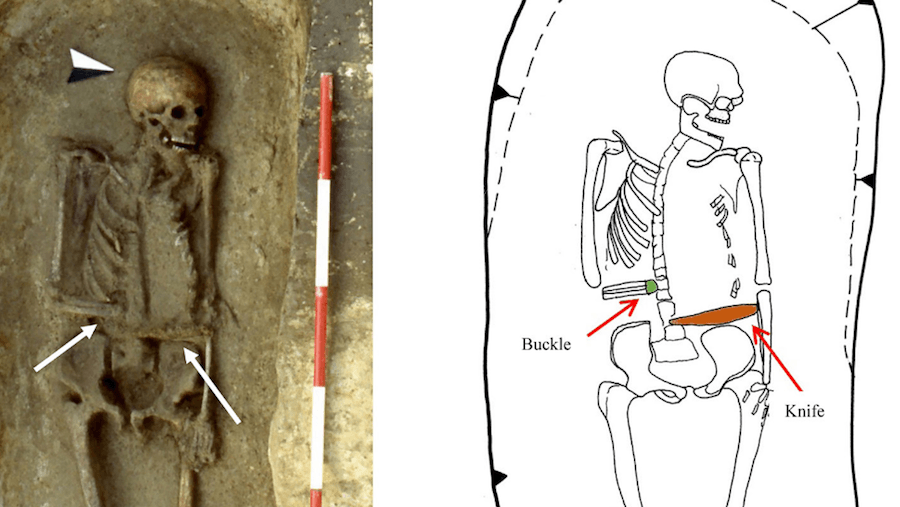Archaeologists have uncovered the skeleton of a warrior in northern Italy from the 6th century who after having his hand amputated, used a knife as a prosthetic hand.

Ileana Micarelli et al.The skeleton with the knife and buckle displayed.
Archaeologists have uncovered something pretty incredible in Northern Italy. Found in a Longobard necropolis, the skeleton of this medieval Italian warrior dates back as far as the 6th century.
And long before Captain Hook, this man from the Lombardy region appears to have used a cap, buckle, and leather straps to attach a prosthetic knife to the stump of his amputated hand.
Published in the Journal of Anthropological Sciences, the finding means not only did he manage to survive a massive amputation procedure, but he was also able to replace the limb with a bladed weapon.
Observing the morphological traits of the skeleton’s skull and pelvis, researchers were able to deduce that it was a male between the ages of 40 and 50.
The stump of his right arm was positioned across his chest, amputated at the mid-forearm. Researchers determined that the hand had been removed by blunt force trauma. A knife blade and a buckle were discovered with him as well.
“One possibility is that the limb was amputated for medical reasons; perhaps the forelimb was broken due to an accidental fall or some other means, resulting in an unhealable fracture,” the researchers from Sapienza University in Rome led by archaeologist Ileana Micarelli wrote. Though they added, “Still, given the warrior-specific culture of the Longobard people, a loss due to fighting is also possible.”
Archeologists have excavated over 160 tombs at the Longobard necropolis, where hundreds of skeletons were buried as well as a headless horse.
But the uniqueness of this one skeleton stood out. While all the others had knives at their arms and weapons laid at their sides, the research team identified this man as having a callus and bone spurs, evidence of biomechanical pressure. The find was consistent with the type of pressure typically applied to a prosthetic device.

Journal of Anthropological SciencesThe teeth exhibited signs of considerable weathering from maintaining his prosthetic hand.
They also noted that his teeth were considerably weathered, which suggested he consistently used them to tighten the straps of the device. Or as the researchers wrote, “points to dental use in attaching the prosthesis to the limb.” Upon further examination it appeared that the man’s shoulder had formed a C-shape ridge of bone, indicating he took an unnatural position in order to frequently tighten the prosthesis using his mouth.
Further CT scans revealed outer bone loss, often the result where there is a prosthesis present.
Prior to the development of antibiotics and sterilization techniques, Micarelli and her team said the find is a “remarkable” example of a person surviving the loss of a limb. It demonstrates that medics at the time had the ability to maintain a clean environment and had the knowledge to prevent blood loss.
The researchers also say that the case shows an environment which provided intensive care and community-level support.
“The strength of his relationship with the community is at the heart of the surgical intervention’s success,” said Micarelli. “And in my opinion, social relations are as important as the level of medical technology.”
Now read about the oldest virus found in a human skeleton. Then read about the most painful medical procedures of the Medieval Period.





